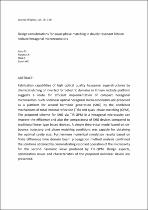 ResearchSpace
ResearchSpace
Design considerations for quasi-phase-matching in doubly resonant lithium niobate hexagonal microresonators
JavaScript is disabled for your browser. Some features of this site may not work without it.
- ResearchSpace
- →
- Research Publications/Outputs
- →
- Journal Articles
- →
- View Item
| dc.contributor.author |
Sono, Tleyane J

|
|
| dc.contributor.author |
Riziotis, CR

|
|
| dc.contributor.author |
Maili, S

|
|
| dc.contributor.author |
Eason, WE

|
|
| dc.date.accessioned | 2017-11-30T06:52:35Z | |
| dc.date.available | 2017-11-30T06:52:35Z | |
| dc.date.issued | 2017-08 | |
| dc.identifier.citation | Sono, T.J. et al. 2017. Design considerations for quasi-phase-matching in doubly resonant lithium niobate hexagonal microresonators. Journal of Optics, vol. 19(9): 1-10 | en_US |
| dc.identifier.issn | 2040-8978 | |
| dc.identifier.uri | http://iopscience.iop.org/article/10.1088/2040-8986/aa8104/meta | |
| dc.identifier.uri | https://www.researchgate.net/publication/318572128_Design_considerations_for_quasi-phase-matching_in_doubly_resonant_Lithium_Niobate_hexagonal_micro-resonators | |
| dc.identifier.uri | http://hdl.handle.net/10204/9832 | |
| dc.description | Copyright: 2017 IOP. Due to copyright restrictions, the attached PDF file only contains the abstract of the full text item. For access to the full text item, please consult the publisher's website. | en_US |
| dc.description.abstract | Fabrication capabilities of high optical quality hexagonal superstructures by chemical etching of inverted ferroelectric domains in lithium niobate platform suggests a route for efficient implementation of compact hexagonal microcavities. Such nonlinear optical hexagonal micro-resonators are proposed as a platform for second harmonic generation (SHG) by the combined mechanisms of total internal reflection (TIR) and quasi-phase-matching (QPM). The proposed scheme for SHG via TIR-QPM in a hexagonal microcavity can improve the efficiency and also the compactness of SHG devices compared to traditional linear-type based devices. A simple theoretical model based on six-bounce trajectory and phase matching conditions was capable for obtaining the optimal cavity size. Furthermore numerical simulation results based on finite difference time domain beam propagation method analysis confirmed the solutions obtained by demonstrating resonant operation of the microcavity for the second harmonic wave produced by TIR-QPM. Design aspects, optimization issues and characteristics of the proposed nonlinear device are presented. | en_US |
| dc.language.iso | en | en_US |
| dc.publisher | IOP Publishing Ltd | en_US |
| dc.relation.ispartofseries | Worklist;19557 | |
| dc.subject | Lithium niobate | en_US |
| dc.subject | Second harmonic generation | en_US |
| dc.subject | Microresonator | en_US |
| dc.subject | Microcavity | en_US |
| dc.subject | Quasi-phase-matching | en_US |
| dc.subject | Total-internal-reflection | en_US |
| dc.subject | Nonlinear | en_US |
| dc.title | Design considerations for quasi-phase-matching in doubly resonant lithium niobate hexagonal microresonators | en_US |
| dc.type | Article | en_US |
| dc.identifier.apacitation | Sono, T. J., Riziotis, C., Maili, S., & Eason, W. (2017). Design considerations for quasi-phase-matching in doubly resonant lithium niobate hexagonal microresonators. http://hdl.handle.net/10204/9832 | en_ZA |
| dc.identifier.chicagocitation | Sono, Tleyane J, CR Riziotis, S Maili, and WE Eason "Design considerations for quasi-phase-matching in doubly resonant lithium niobate hexagonal microresonators." (2017) http://hdl.handle.net/10204/9832 | en_ZA |
| dc.identifier.vancouvercitation | Sono TJ, Riziotis C, Maili S, Eason W. Design considerations for quasi-phase-matching in doubly resonant lithium niobate hexagonal microresonators. 2017; http://hdl.handle.net/10204/9832. | en_ZA |
| dc.identifier.ris | TY - Article AU - Sono, Tleyane J AU - Riziotis, CR AU - Maili, S AU - Eason, WE AB - Fabrication capabilities of high optical quality hexagonal superstructures by chemical etching of inverted ferroelectric domains in lithium niobate platform suggests a route for efficient implementation of compact hexagonal microcavities. Such nonlinear optical hexagonal micro-resonators are proposed as a platform for second harmonic generation (SHG) by the combined mechanisms of total internal reflection (TIR) and quasi-phase-matching (QPM). The proposed scheme for SHG via TIR-QPM in a hexagonal microcavity can improve the efficiency and also the compactness of SHG devices compared to traditional linear-type based devices. A simple theoretical model based on six-bounce trajectory and phase matching conditions was capable for obtaining the optimal cavity size. Furthermore numerical simulation results based on finite difference time domain beam propagation method analysis confirmed the solutions obtained by demonstrating resonant operation of the microcavity for the second harmonic wave produced by TIR-QPM. Design aspects, optimization issues and characteristics of the proposed nonlinear device are presented. DA - 2017-08 DB - ResearchSpace DP - CSIR KW - Lithium niobate KW - Second harmonic generation KW - Microresonator KW - Microcavity KW - Quasi-phase-matching KW - Total-internal-reflection KW - Nonlinear LK - https://researchspace.csir.co.za PY - 2017 SM - 2040-8978 T1 - Design considerations for quasi-phase-matching in doubly resonant lithium niobate hexagonal microresonators TI - Design considerations for quasi-phase-matching in doubly resonant lithium niobate hexagonal microresonators UR - http://hdl.handle.net/10204/9832 ER - | en_ZA |





